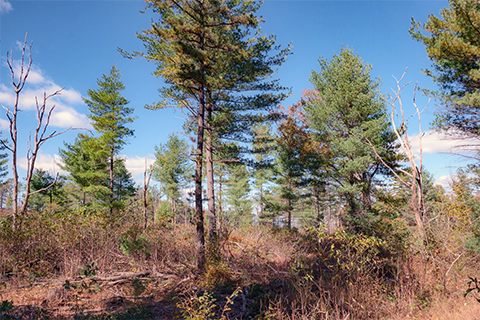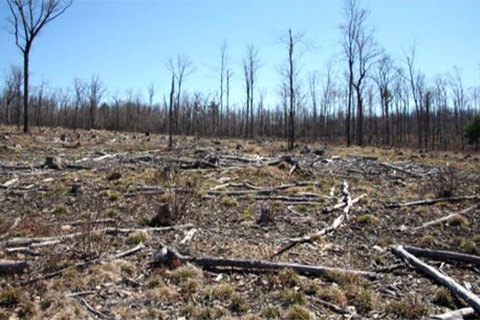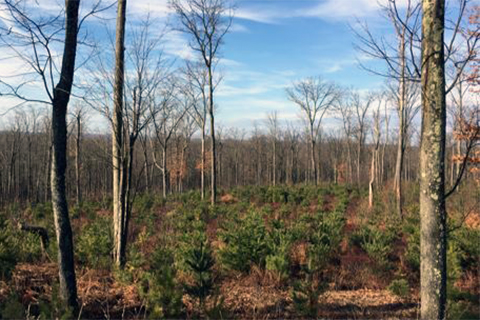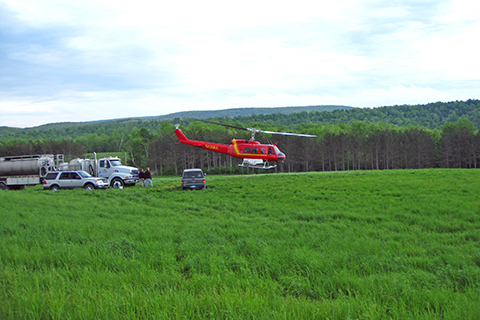This spring, DCNR is undertaking an aerial spraying effort to combat the invasive gypsy moth (gypsy moth is the common name, Lymantria dispar is the scientific name for this forest pest).
Also this season, the department has completed planting 950,000 seedlings in Moshannon State Forest in Centre County -- an area that showed the devastation that can occur when this invasive insect is left unchecked.
The planting area is about 40,000 acres of Moshannon State Forest, which surrounds Black Moshannon State Park, that was devastated by Lymantria dispar defoliations in 2007 and 2008.
Close to one million conifer tree seedlings were planted this month.
Since 2010, staff and contractors have planted more than five million trees, adding fast-growing species like white pine, red pine, and white spruce.
Planting Conifers for Restoration, Not Oaks

Why opt for planting conifers when gypsy moths are notorious for destroying oaks, which is exactly what happened in the Moshannon?
The reason is simple; conifers provide a relatively quick return to a healthy forest, with advantages including:
- Fast growth rate;
- Less browsing pressure from deer; and
- Generally better developed root systems as seedlings.
The rapidly maturing conifer forest enriches the soil with organic material from shed needles, setting the stage for regeneration of other species, including oaks.
The relatively few remaining deciduous overstory trees provide a seed source that will diversify the species composition, while the conifers in the understory will provide shelter for naturally germinating seedlings.
Circumstances That Led to Forest Devastation

To think that planting more than five million trees would be necessary to return a forest to a healthy condition might come as a surprise to some, but this was the reality in the aftermath of the defoliations of the late 2000s in Moshannon State Forest.
DCNR’s Bureau of Forestry routinely carries out effective Lymantria dispar suppression on a nearly annual basis, but forest managers during that era were met with a perfect storm of challenges.
Coupled with austerity measures and major, statewide outbreaks of gypsy moths, forest managers were forced to spread out suppression efforts across the state. There just wasn’t enough funding to carry out the necessary gypsy moth suppression work in Moshannon State Forest during that period.
A Resounding Restoration Success

Replanting efforts have resulted in establishment of millions of trees, some of which are approaching 10 feet tall.
Of 24 planting blocks sampled, the majority (14 out of 24) demonstrated remarkable seedling survival of more than 50 percent.
A growing forest is thriving once again. Forest dwellers dependent upon coniferous and mixed forests are finding a perfect home in this part of Moshannon State Forest.
Avoiding Gypsy Moth Damage

DCNR strives to avoid a situation that requires such an arduous forest restoration effort.
It is much more cost-effective to protect an existing forest than it is to restore one.
This year, DCNR’s Bureau of Forestry is currently treating more than 200,000 acres of commonwealth forests to avert the ravages of this invasive forest pest.
Find more information about Lymantria dispar and an interactive map that shows aerial spraying progress, visit the DCNR website.
Editor’s note: The Entomological Society of America, which sets common names for insects, is looking into changing the name gypsy moth because of its racist implications. DCNR is using both the common and scientific names to ensure the public knows what insect is being referenced as the transition occurs.